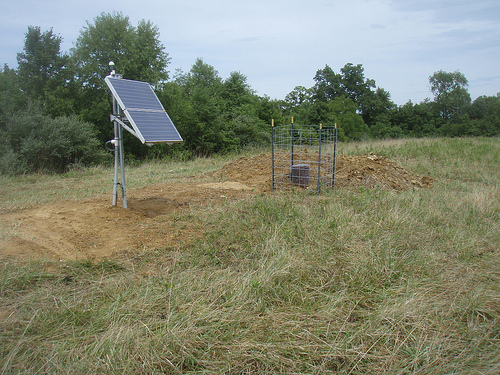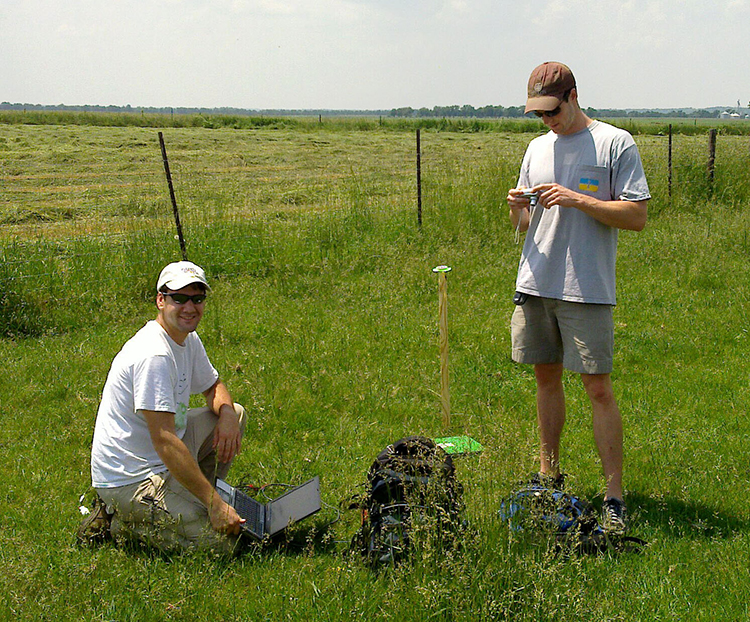P52A
Corning, OH, USA
The USArray component of the NSF-funded EarthScope project ended its observational period in September 2021 and all remaining close-out tasks concluded in March 2022. Hundreds of seismic stations were transferred to other operators and continue to collect scientific observations. This USArray.org website is now in an archival state and will no longer be updated. To learn more about this project and the science it continues to enable, please view publications here: http://usarray.org/researchers/pubs and citations of the Transportable Array network DOI 10.7914/SN/TA.
To further advance geophysics support for the geophysics community, UNAVCO and IRIS are merging. The merged organization will be called EarthScope Consortium. As our science becomes more convergent, there is benefit to examining how we can support research and education as a single organization to conduct and advance cutting-edge geophysics. See our Joining Forces website for more information. The site earthscope.org will soon host the new EarthScope Consortium website.




By Maia ten Brink
James Taylor, a geology student at Auburn University in Alabama, used to be terrified of public speaking. He swore it off after he coughed through a speech in eighth grade, and he got almost all the way through his undergraduate career at Auburn without having to speak in front of strangers. One day during his senior year, however, geology professor Dr. Lorraine Wolf emailed about a summer job that required students to approach landowners all over Alabama and ask them to participate in a national seismology experiment called EarthScope. At first, Taylor dismissed the email, but then he began to wonder if it might help him come out of his shell. He was considering graduate school and knew he would have to teach a roomful of students. “I thought it was going to give me some opportunities to learn how to talk to people one-on-one and it would keep me out of my comfort zone,” Taylor said.
Now he includes “Seismic site locator for EarthScope, Summer 2010” on every resume. “When people ask me about it, I can’t shut up about it. It was a big thing in my life,” he said.

James Taylor (left) and Stan Ingram (right).
Taylor was paired with Stan Ingram, a geology graduate student at the University of Alabama, to find 23 seismometer sites throughout the state. They quickly hit on a strategy to connect to landowners: play to the football teams. Alabama is split by a fierce football rivalry between Auburn University and the University of Alabama.
Taylor, in his Auburn hat, and Ingram, in his Crimson Tide hat, would drive up to a house in their white Chevy Impala with a University of Alabama magnet on the door. (Taylor enjoyed the shocked looks elicited when someone saw him wearing his Auburn hat while driving the Alabama car.) If Taylor and Ingram saw any crimson flags, signs, or elephants indicating a diehard Alabama fan, Ingram would make the first overture. If Auburn’s orange and navy blue colors hailed them in the front yard, Taylor would do the knocking and talking. “They were usually pretty nice, but there were some people that would just talk to him and some people that would just talk to me. That’s how bitter the rivalry was,” he said.
Many landowners would usher Taylor and Ingram into sitting rooms dedicated to their chosen team. In central Alabama, one man showed them an impressive “Alabama room” painted crimson and bedecked with team photos, watercolor prints of famous plays, lots of houndstooth, and elephant memorabilia.
When they first pulled up to his home, they saw a shirtless giant in the yard with his granddaughter. “He must’ve been about seven foot tall. He’s probably in his sixties, but he’s the most ripped person I’ve ever seen,” said Taylor.
“Can I help you?” asked the man in a deep, threatening voice. He pushed his granddaughter behind him.
“I almost turned around; he looked really intimidating,” recalled Taylor. “But a couple of hours later, we were best buddies with this guy.” The man revealed that he had been an Olympic javelin thrower once ranked third in the country. He described his favorite full-body workout: beating on one of the old tractor tires lying around his yard with a wood splitter until he tired out. “I wouldn’t have wanted to be his enemy,” Taylor said.
Most people invited Taylor and Ingram into their homes even if they could not host a seismometer station. Taylor, a Cincinnati native, appreciated the Southern hospitality. “If I were in Ohio, I would have been getting doors slammed in my face,” he said.
The optimal place to put a seismometer was in the middle of cleared fields, but farms could rarely spare the space for a seismometer in a seven-foot-deep vault. Taylor and Ingram got their first site with the help of the Alabama Cattleman’s Association, which boasted a chapter in every county. A retired couple in northern Alabama couldn’t host a site themselves, but drove Taylor and Ingram down to the local Cattleman’s Association cattle show and introduced them to the president of the local chapter. The chapter president took them out in his pasture to discuss possible locations for the seismometer. The cattle came running to investigate.
“Cows can look cute, but it gets to be intimidating when they come in groups. You get a big wall of animal,” said Taylor. “They are not going to move if they don’t want to.” The chapter president carried a large whip and cracked it in the air to disperse the cattle. “I was sitting there thinking, ‘Oh my goodness. No sudden movements,’” said Taylor.
“We did end up saving a cow,” he remembered. Somebody answered the door in central Alabama with a British accent. Taylor’s first thought was, “Where am I?” It turned out that the family who owned the property did horseback fox-hunting, a traditional aristocratic sport that is no longer legal in Britain. They gave Taylor and Ingram free reign to roam the grounds to find a good seismometer site. The team located a low spot, blocked from the road by trees. There they found a cow up to its back in mud. “It was a little bit emaciated; it had been there for a while,” Taylor said. “They would never have seen it if we weren’t out strolling around.” The family called the fire department and pulled the cow out of the muck.
Taylor encountered a menagerie of animals, including horses, sheep, goats, and catfish. He saw his first wild bald eagle while siting in timberlands in west central Alabama. Outside Birmingham, a medical doctor took them to a small piece of property tucked away behind his house. The doctor gave them a look and then asked, “Have you ever seen a zonkey?” He introduced them to his pet zebra-donkey hybrid. Taylor and Ingram staked out a seismometer site next to the zonkey.
Sometimes they would run across stray dogs. He explained, “You always have to be careful because you’re not sure which dogs are friendly and which dogs aren’t. People will train dogs for dogfighting. A lot of times, if a dog loses a fight, they will just get rid of it. It’s terrible.” Taylor’s father operates a hunting lodge in Midway, Alabama, and hosted an EarthScope seismometer on his property. Taylor said that a hunter at his father’s lodge found nine pit bulls over the course of a week.
Even pets could be vicious. “There was somebody’s house,” remembered Taylor, “where I pulled into the driveway and there were two Rottweilers. They were coming up the car door and about to bite the tire off. I just backed out and left. I wasn’t even going to get out of the car.”
Taylor and Ingram worked four days a week, sixteen hours a day. Several times, they found three sites in a day. “That was a little bit of luck, preparation, and a lot of driving.”
From Taylor’s home in Cincinnati, Ohio, to Auburn, Alabama, is a 9-hour, 900 km drive on interstates. Some days, Taylor would drive that distance within the state of Alabama on winding country roads, passing tomato, cotton, and tree farms, cattle pastures, and oil derricks. “I actually liked the driving off the interstate much more than on the interstate. That’s just because I was seeing things I didn’t normally see,” said Taylor. Rural Alabama didn’t always conform to “hick-town” stereotypes. Taylor sometimes stumbled across plantations and mansions and had to finagle his way past electronic gates in order to knock the doors and speak with a landowner.
Taylor also got to see Alabama’s geological variation. Cincinnati sits on slow-formed, smooth sedimentary rocks like sandstone, limestone, and shale—none of the crystals or metamorphic rocks formed under intense heat and pressure that can be found in Alabama. The hills of northern Alabama are ancient mountains at the edge of the Appalachian range. “There were times when we would be driving down the hill and I was worried I was going to burn the brakes up because we were going downhill for 35 minutes,” Taylor said.
“To me, what I was doing was touristy, driving around and seeing the state, rather than stopping at some psychic reader in this little one-light town,” he said. “Every day was different; that was the best part. I remember telling Stan, ‘I wish I could do this forever.’”
Working for EarthScope changed the course of Taylor’s studies. Sitting in countless kitchens and living rooms explaining the science behind the EarthScope projects made him want to be able to answer people’s questions more thoroughly. He stayed at Auburn University for a Master’s Degree, studying potential fields, gravity, and magnetics under Dr. Lorraine Wolf, the faculty member who had sent him that first email about EarthScope.
Taylor thinks more people should participate in “cultural exchanges” in their own state. “It helped give me a broader picture of how things are,” he said. “It opened my eyes to the fact that everybody has a different story. It was cool to be personally involved in people’s lives, even just for a couple of hours. Some of them had great stories. Some of them had sad stories. It helped me take a step back; it was a little bit of a humbling experience.”
And all that talking did exactly what Taylor originally wanted: made him more comfortable in his skin. “It made me be able to go up and talk to people and see that they’re not going to be scared away. They’re wanting to talk too.” He taught his first lab in graduate school six months after the EarthScope job. “I was sweating, but I started thinking about that summer and I thought, ‘You know, I’ve got this.’ I went in there and taught my lab, and it was good.”